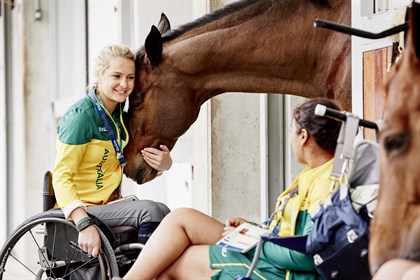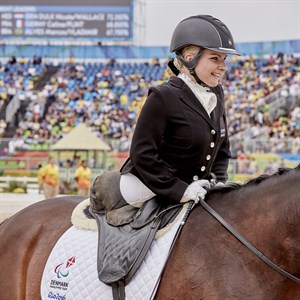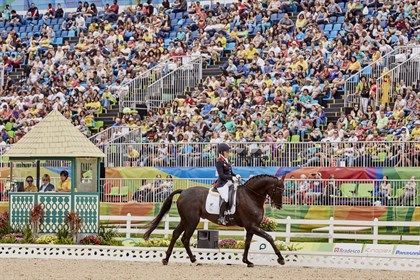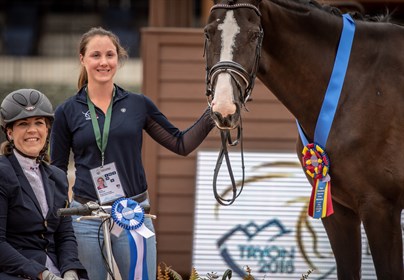|

Australian Para Dressage rider, Emma Booth
© Liz Gregg
Para Dressage is conducted under the same basic rules as conventional Dressage, but with riders divided into different competition Grades based on functional abilities. It is incredible how these athletes do not let any impairments stop them from doing what they love. Before we dive into what Para Dressage entails, lets read a few fast facts here and then find out more details below:
- Horses must be 9 years old.
- Athletes must be at least 16 years old.
- When an athlete makes an “error of the course” (takes a wrong turn, omits a movement, etc.) the Judge at C warns them by sounding a bell. The Judge shows them, if necessary, the point at which they may go back and make up the test.
- Those with visual impairments may use a caller to call out letters to them.
- Those with hearing impairments may use a commander who can sign the test to them by standing at either letter E or B outside of the arena.
- Athletes are allowed compensating aids including special equipment or prostheses needed to ride. A few examples are saluting with head only, sitting or rising trot, a saddle of any type, elastic bands on stirrups, 1 whip, safety vest, etc.
- An arm band in a distinctive color must be worn at all times by Grade IV and V athletes with visual impairment while they are mounted outside of the competition arena.
Already know you want to come watch Para Dressage in September? Click here for tickets!
Para Dressage will be held over five days during the second week. Scroll down learn about how athletes are placed into the correct Grade, and get a day by day breakdown of the competition!
How Grades of Para Dressage are Determined
Grade I: Athletes in Grade I have severe impairments affecting all limbs and trunk. These athletes usually require a wheelchair. When these athletes compete, their test is completed through the walk and they may not show a canter, piaffe or passage.
Grade II: Athletes in this Grade have either a severe impairment of the trunk and minimal impairment of the upper limbs or moderate impairment of the trunk, upper and lower limbs. Most athletes in this grade also use a wheelchair in daily life. These athletes complete their tests through the walk and the trot and they may not show a canter, piaffe or passage.
Grade III: These athletes have severe impairments in both lower limbs with minimal or no impairment of the trunk. Or they have moderate impairment of the upper and lower limbs and trunk. Athletes in this Grade may use a wheelchair in daily life. These athletes also compete at a walk and a trot and may not show a piaffe or passage. They can only show canter work that does not include lateral work, flying changes, half or full pirouettes.

Competition time
© Liz Gregg
Grade IV: Athletes in Grade IV have severe impairment or deficiency of both upper limbs or a moderate impairment of all four limbs or short stature. These athletes are usually able to walk and generally do not require a wheelchair in daily life. Athletes with visual impairments such as very low visual acuity and/or no light perception also fall into this Grade. Athletes in this Grade compete at the walk, trot, with lateral work, and the canter.
Grade V: The final Grade of Para Dressage includes athletes who have very mild impairment of movement or muscle strength or a deficiency of one limb or a mild deficiency of two limbs. These athletes may also have visual impairments that are less severe than those competing in Grade IV and/or a visual field of less than 5 degrees radius. Athletes in this Grade compete at a walk, trot and canter with lateral work but they may not show a piaffe, passage, one or two times sequence changes, or full pirouettes.
*An Athlete that intentionally shows disallowed paces or movements during the execution of the test will have eight marks deducted by each Judge each time a not allowed movement is shown, and a choreography mark of five or below, but no elimination.
September 18: Individuals Day 1 and Medal Ceremony
Each Individual will perform their test based on the Grade they are assigned. All five grades will compete, and individual medals will be awarded for each Grade. In all competitions, the winner is the Athlete having obtained the highest percentage, the second placed Athlete is the one with the next highest percentage and so on.
September 19: Individuals Day 2 and Medal Ceremony
The competition will run the same as Day 1, and there are sets of medals for each of the five Grades for the Individual Championships.

Para dressage
© Liz Gregg
September 20: Team Day 1
The declaration of the teams will take place after the Individual Championships each day, and each team must have at least one athlete in Grade I, II or III and a team may not include more than two Athletes from any one Grade. The scores of all three team members obtained at the team test count for the team result (no drop score). In all competitions, the winner is the team having obtained the highest percentage, the second placed team is the one with the next highest percentage and so on.
A fun fact about team competitions is the Chef d’Equipes can decide the starting order of their own team athletes.
September 21: Team Day 2 and Medal Ceremony
Team Day 2 will run the same as Day 1, with the medal ceremony to follow competition.
September 22: Individual Freestyle and Medal Ceremony
Grade I, Grade II and Grade III Freestyle to Music Tests must be no shorter than four minutes and no longer than four minutes and thirty seconds. Then music for Grade IV and Grade V Freestyle, the song must be no shorter than four minutes thirty seconds, and no longer than five minutes. The music must not start more than thirty seconds before the Athlete enters the arena, and the music must cease at the final salute. Freestyle is all about coordinating the horses movements with the music!
The starting order for Freestyle to Music Competitions will be drawn in groups of four, using the qualifying results. The first four to compete in the Freestyle will be the four lowest scoring combinations. The last four to compete in the Freestyle will be the four highest scoring combinations.
Similar to individual championships and team championships, there are sets of medals for each of the five Grades for the Freestyle to Music Championship.

award ceremony
© Kim Beaudoin
Now that you know more about the Para Dressage competition, it’s time to purchase your tickets and come cheer on your teams or individual riders this September!
Para Dressage tickets are available now by clicking here.
Para Dressage Schedule:?
September 18: Individuals Day 1 and Medal Ceremony
?September 19: Individuals Day 2 and Medal Ceremony?September 20: Team Day 1?
September 21: Team Day 2 and Medal Ceremony?
September 22: Individual Freestyle and Medal Ceremony?
Source: FEI World Equestrian Games website
|

